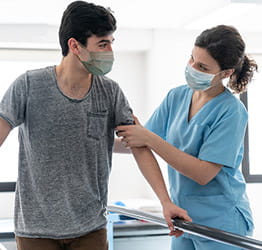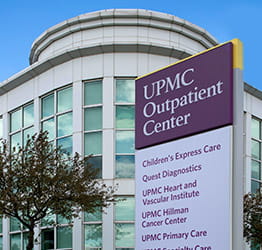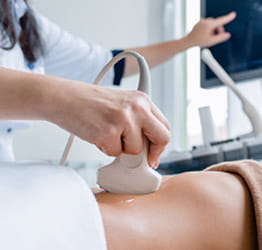On this page
What Is Tricuspid Valve Regurgitation?
The heart controls blood flow through four valves — the aortic, mitral, pulmonary, and tricuspid valves. Two of these valves — tricuspid and mitral — have large flaps called leaflets that open and close to control blood flow from the top chambers (atrium) to the bottom chambers (ventricles) of the heart. When the valve doesn’t close properly, some blood can flow backward, a condition known as regurgitation.
Tricuspid valve regurgitation (TR) means that instead of blood flowing from the right atrium to the right ventricle before exiting the heart, blood is leaking back into the right atrium.
This type of heart valve disease can vary in severity and symptoms, ranging from no apparent symptoms to severe symptoms that significantly impact daily life. The entire cardiovascular system is at risk of weakening and failing if tricuspid valve regurgitation is left untreated.
What are the types of tricuspid valve regurgitation?
The types of tricuspid valve regurgitation are:
- Primary — This type of regurgitation, also known as degenerative tricuspid regurgitation, is typically caused by an abnormality that was present at birth or an infection that has damaged your heart valve at some point.
- Secondary — This type of regurgitation, also known as functional regurgitation, typically results from an underlying medical condition that causes the heart valve to regurgitate. It is the most common type of tricuspid regurgitation.
How common is tricuspid valve regurgitation?
Mild TR is quite common. Since symptoms don’t appear for most people, the condition is considered benign or non-life-threatening. More severe cases of the condition are less common, with up to 8 of every 1,000 people in the United States having been diagnosed.
What causes tricuspid valve regurgitation?
For primary tricuspid regurgitation, the most common causes include:
- Abnormality from birth.
- Endocarditis — An infection in the bloodstream that leads to heart valve damage.
- Rheumatic fever — A childhood illness that can lead to scarring of the leaflets.
- Traumatic injury that can cause rupture of the valve apparatus.
For secondary or functional tricuspid regurgitation, an underlying medical condition is causing the symptoms.
These conditions could include:
- Atrial fibrillation.
- Cardiomegaly — Enlarged heart.
- Cardiomyopathy — Heart muscle disease.
- Coronary artery disease.
- Pulmonary hypertension — High blood pressure in the pulmonary arteries.
- Other medical conditions that affect the heart valve function, such as radiation or certain drugs, connective tissue or systemic inflammatory diseases, carcinoid syndrome, and pacemaker leads.
What are tricuspid valve regurgitation risk factors and complications?
Tricuspid valve regurgitation risk factors
You are at a higher risk for TR if you have:
- Advanced age.
- Heart disease or other cardiovascular disorders, such as heart attack, atrial fibrillation, pacemaker, or mitral valve disease.
- Pulmonary hypertension.
- Other medical conditions of the heart valve or cardiovascular system, such as chronic lung disease, prior chest radiation, systemic inflammatory disease, connective tissue disease
Complications of tricuspid valve regurgitation
If left untreated, TR can cause moderate to severe symptoms that impact daily life, including:
- Atrial fibrillation — A heart rhythm disorder.
- Heart failure.
- Organ failure, such as kidney and liver failure.
How can I prevent tricuspid valve regurgitation?
While it is not possible to completely prevent tricuspid valve regurgitation, there are some heart-healthy measures you can take to lower your chances of cardiovascular conditions.
These include:
- Avoiding or severely limiting alcohol and tobacco products.
- Controlling chronic conditions such as high blood pressure and high cholesterol.
- Eating a balanced, heart-healthy diet.
- Maintaining an exercise routine.
- Maintaining a healthy weight.
- Staying up to date on yearly doctor visits and exams.
Back to top.
What Are the Signs and Symptoms of Tricuspid Valve Regurgitation?
Many people with mild tricuspid regurgitation do not feel any symptoms. They may have been diagnosed with the condition without being aware they had it. For others, symptoms range from mild to severe and may differ depending on the type of regurgitation.
The most common symptoms are:
- Heart murmur.
- Heart palpitations or abnormal heart rhythm.
- Loss of appetite.
- Right upper quadrant discomfort or pain.
- Shortness of breath after moving or exercising.
- Strong pulse near the liver or neck.
- Swelling in the abdomen, ankles, and feet.
- Weakness and fatigue.
When should I see a doctor about my tricuspid valve regurgitation symptoms?
If you are experiencing any of the above symptoms, it is important to set up an appointment with your primary care physician. Receiving quick treatment for TR can help reduce symptoms and keep the condition from worsening.
How Do You Diagnose Tricuspid Valve Regurgitation?
First, your doctor will ask you a series of questions relating to your symptoms and health history. It is normal for your doctor to perform a physical exam using a stethoscope to monitor your breathing and heartbeat. They may apply pressure to parts of your body that have a pulse, such as the neck.
Next, your doctor will likely order an echocardiogram (ECG) to formally diagnose the condition. This ultrasound test assesses the function of your heart and is typically performed using a handheld ultrasound device placed on your chest to capture images.
Your doctor may also order some other tests to help make a formal diagnosis and rule out underlying conditions, including:
Back to top.
How Do You Treat Tricuspid Valve Regurgitation?
Treatment for tricuspid valve regurgitation varies greatly based on your symptoms and the type of regurgitation. For many asymptomatic people, there is no treatment beyond general monitoring for worsening symptoms.
For others, medication and surgery are the most successful treatment options.
Medications to treat tricuspid valve regurgitation
Your doctor may prescribe medications to manage symptoms or treat any underlying medical conditions that are causing the disorder. Diuretics (water pills) are a commonly prescribed medication that can ease symptoms and help people live normal, functional lives with the condition.
Surgery to treat tricuspid valve regurgitation
UPMC performs both traditional open surgery and minimally invasive surgery to repair tricuspid valve regurgitation and improve quality of life.
Open heart surgery
If the regurgitation is caused by a leaflet problem from rheumatic fever, infection, or congenital abnormality, then open heart surgery may be recommended. In open heart surgery, a large incision is made in the chest to allow the surgeon to access the heart and restore the tricuspid valve's normal function by repairing or replacing the existing valve.
UPMC tailors treatment to individual anatomy as well as clinical history and complexity.
Tricuspid valve replacement surgery
Our team may perform tricuspid valve replacements for moderate to severe cases of TR if repair isn't an option because of:
- Heavy calcium.
- Infection.
We replace tricuspid valves with either biologic valves or mechanical valves.
There are pros and cons with each:
- Biologic valves are made of cow or pig tissue. These valves don't last as long as metal ones, but they often don't require you to take lifelong blood thinners. Depending on your age and condition at the time of surgery, tissue valves may eventually need replacement.
- Mechanical valves have metal flaps that are long-lasting but require you to take a blood thinner for life.
Minimally invasive tricuspid valve surgery
Minimally invasive approaches to tricuspid valve repair involve making a small incision on the front or right side of the chest. This technique is less invasive than open chest surgery.
These smaller cuts to access the heart may lead to:
- Faster recovery, allowing you to get back to your life sooner.
- Fewer postoperative restrictions.
- Less surgical trauma.
- Reduced risk of infection.
Minimally invasive robotic-assisted tricuspid valve surgery
UPMC is a leader in minimally invasive robotically assisted tricuspid valve repair.
This approach allows the surgical team to access the tricuspid valve through a small, minimally invasive incision between the ribs. By utilizing the robot, the valve is visualized directly with much higher definition, resulting in greater surgical precision.
Compared to some other types of surgery, robotically assisted minimally invasive valve repair offers:
- Faster recovery and return to your daily routine.
- Fewer postoperative restrictions. Patients can return to driving once they are no longer requiring narcotics. There are no lifting restrictions after robotically assisted cardiac surgery.
- Less surgical trauma.
After minimally invasive and robotically assisted tricuspid valve repair surgery, most people:
- Can do some activities for the first three to four weeks post-op, avoiding heavy lifting and driving. Your doctor will explain what you can and can't do.
- Get off the breathing machine quickly, sometimes while still in the OR.
- Stay in the hospital for three to five days before going home.
After three to four weeks of recovery, you can slowly return to normal activity, including driving, and begin outpatient cardiac rehab.
Transcatheter edge-to-edge repair (TEER)
UPMC is a leader in transcatheter edge-to-edge repair, a minimally invasive approach to TR valve repair. UPMC experts perform this procedure through a vein in the leg. The surgeon passes a catheter with a clip into the heart and uses the clip to bring the tricuspid valve's leaflets together.
UPMC uses the only commercially available system: Abbott's TriClip® System. Surgeons often use the TEER technique to treat people who are intermediate- or high-risk for open heart valve surgery. This method is associated with faster recovery times, improved quality of life, and improved heart function by reducing tricuspid regurgitation.
Transcatheter tricuspid valve replacement
UPMC offers a minimally invasive approach to tricuspid valve replacement. With transcatheter tricuspid valve replacement (TTVR), UPMC experts place a new biologic prosthetic heart valve inside your existing tricuspid valve through a thin, flexible catheter.
UPMC uses the only commercially available system: the Edwards EVOQUE System. Surgeons often use the TTVR technique to treat people who may be unsuitable for open-heart surgery.
Lifestyle changes to treat tricuspid valve regurgitation
It is important to monitor your health habits when diagnosed with a heart condition. Proper exercise, a healthy diet, mindfulness techniques, and quitting smoking can all have positive effects on your cardiovascular health. Brushing your teeth regularly and keeping your skin clean and moisturized can also influence your heart health.
Back to top.
By UPMC Editorial Staff. Last reviewed on 2025-09-09.
















